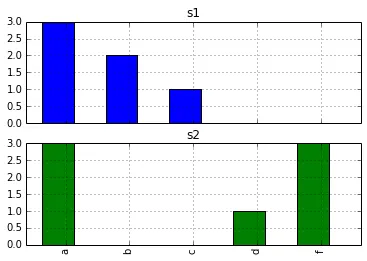假设我有一个像这样创建的DataFrame:
import pandas as pd
s1 = pd.Series(['a', 'b', 'a', 'c', 'a', 'b'])
s2 = pd.Series(['a', 'f', 'a', 'd', 'a', 'f', 'f'])
d = pd.DataFrame({'s1': s1, 's2', s2})
真实数据中的字符串非常稀疏。我希望创建出与d.hist()生成的s1和s2的直方图类似(例如,带有子图的直方图)的字符串出现次数的直方图(每个子图一个)。
仅执行d.hist()会出现以下错误:
/Library/Python/2.7/site-packages/pandas/tools/plotting.pyc in hist_frame(data, column, by, grid, xlabelsize, xrot, ylabelsize, yrot, ax, sharex, sharey, **kwds)
1725 ax.xaxis.set_visible(True)
1726 ax.yaxis.set_visible(True)
-> 1727 ax.hist(data[col].dropna().values, **kwds)
1728 ax.set_title(col)
1729 ax.grid(grid)
/Library/Python/2.7/site-packages/matplotlib/axes.pyc in hist(self, x, bins, range, normed, weights, cumulative, bottom, histtype, align, orientation, rwidth, log, color, label, stacked, **kwargs)
8099 # this will automatically overwrite bins,
8100 # so that each histogram uses the same bins
-> 8101 m, bins = np.histogram(x[i], bins, weights=w[i], **hist_kwargs)
8102 if mlast is None:
8103 mlast = np.zeros(len(bins)-1, m.dtype)
/System/Library/Frameworks/Python.framework/Versions/2.7/Extras/lib/python/numpy/lib/function_base.pyc in histogram(a, bins, range, normed, weights, density)
167 else:
168 range = (a.min(), a.max())
--> 169 mn, mx = [mi+0.0 for mi in range]
170 if mn == mx:
171 mn -= 0.5
TypeError: cannot concatenate 'str' and 'float' objects
我想我可以手动地逐个系列进行value_counts(),然后将其绘制成柱状图,并手动创建子图。我想确认是否有更简单的方法。
